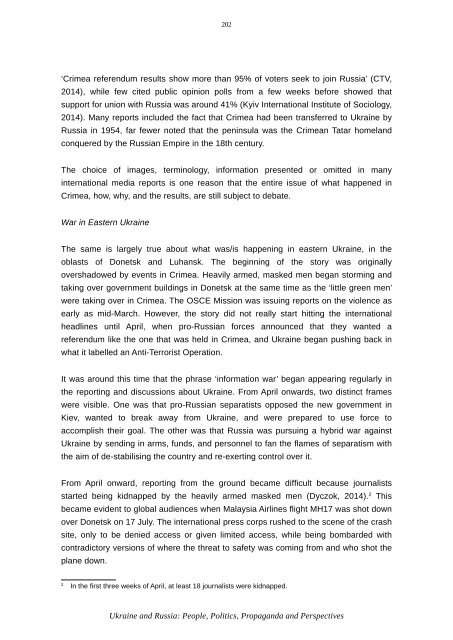Ukraine-and-Russia-E-IR
Ukraine-and-Russia-E-IR
Ukraine-and-Russia-E-IR
You also want an ePaper? Increase the reach of your titles
YUMPU automatically turns print PDFs into web optimized ePapers that Google loves.
202<br />
‘Crimea referendum results show more than 95% of voters seek to join <strong>Russia</strong>’ (CTV,<br />
2014), while few cited public opinion polls from a few weeks before showed that<br />
support for union with <strong>Russia</strong> was around 41% (Kyiv International Institute of Sociology,<br />
2014). Many reports included the fact that Crimea had been transferred to <strong>Ukraine</strong> by<br />
<strong>Russia</strong> in 1954, far fewer noted that the peninsula was the Crimean Tatar homel<strong>and</strong><br />
conquered by the <strong>Russia</strong>n Empire in the 18th century.<br />
The choice of images, terminology, information presented or omitted in many<br />
international media reports is one reason that the entire issue of what happened in<br />
Crimea, how, why, <strong>and</strong> the results, are still subject to debate.<br />
War in Eastern <strong>Ukraine</strong><br />
The same is largely true about what was/is happening in eastern <strong>Ukraine</strong>, in the<br />
oblasts of Donetsk <strong>and</strong> Luhansk. The beginning of the story was originally<br />
overshadowed by events in Crimea. Heavily armed, masked men began storming <strong>and</strong><br />
taking over government buildings in Donetsk at the same time as the ‘little green men’<br />
were taking over in Crimea. The OSCE Mission was issuing reports on the violence as<br />
early as mid-March. However, the story did not really start hitting the international<br />
headlines until April, when pro-<strong>Russia</strong>n forces announced that they wanted a<br />
referendum like the one that was held in Crimea, <strong>and</strong> <strong>Ukraine</strong> began pushing back in<br />
what it labelled an Anti-Terrorist Operation.<br />
It was around this time that the phrase ‘information war’ began appearing regularly in<br />
the reporting <strong>and</strong> discussions about <strong>Ukraine</strong>. From April onwards, two distinct frames<br />
were visible. One was that pro-<strong>Russia</strong>n separatists opposed the new government in<br />
Kiev, wanted to break away from <strong>Ukraine</strong>, <strong>and</strong> were prepared to use force to<br />
accomplish their goal. The other was that <strong>Russia</strong> was pursuing a hybrid war against<br />
<strong>Ukraine</strong> by sending in arms, funds, <strong>and</strong> personnel to fan the flames of separatism with<br />
the aim of de-stabilising the country <strong>and</strong> re-exerting control over it.<br />
From April onward, reporting from the ground became difficult because journalists<br />
started being kidnapped by the heavily armed masked men (Dyczok, 2014). 2 This<br />
became evident to global audiences when Malaysia Airlines flight MH17 was shot down<br />
over Donetsk on 17 July. The international press corps rushed to the scene of the crash<br />
site, only to be denied access or given limited access, while being bombarded with<br />
contradictory versions of where the threat to safety was coming from <strong>and</strong> who shot the<br />
plane down.<br />
2<br />
In the first three weeks of April, at least 18 journalists were kidnapped.<br />
<strong>Ukraine</strong> <strong>and</strong> <strong>Russia</strong>: People, Politics, Propag<strong>and</strong>a <strong>and</strong> Perspectives


